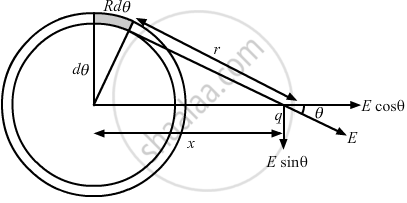Advertisements
Advertisements
प्रश्न
A positive charge Q is distributed uniformly over a circular ring of radius R. A particle of mass m, and a negative charge q, is placed on its axis at a distance x from the centre. Find the force on the particle. Assuming x << R, find the time period of oscillation of the particle if it is released from there .
उत्तर
Consider an element of angular width \[d\theta\] at a distance r from the charge q on the circular ring, as shown in the figure.

\[dE = \frac{dq}{4\pi \epsilon_0}\frac{1}{r^2}\]
\[ = \frac{\frac{Q}{2\pi}d\theta}{4\pi \epsilon_0}\frac{1}{R^2 + x^2}\]
By the symmetry, the E sinθ component of all such elements on the ring will vanish.
So, net electric field,
\[d E_{net} = dE\cos\theta = \frac{Qd\theta}{8 \pi^2 \epsilon_0 \left( R^2 + x^2 \right)^{3/2}}\]
Total force on the charged particle,
\[F = \int qd E_{net} \]
\[ = \frac{qQ}{8 \pi^2 \epsilon_0}\frac{x}{\left( R^2 + x^2 \right)^{3/2}} \int_0^{2\pi} d\theta\]
\[ = \frac{xQq}{4\pi \epsilon_0 \left( R^2 + x^2 \right)^{3/2}}\]
According to the question,
\[x < < R\]
\[F = \frac{Qq x}{4\pi \epsilon_0 R^3}\]
Comparing this with the condition of simple harmonic motion, we get
\[F = m \omega^2 x\]
\[ \Rightarrow m \omega^2 = \frac{Qq}{4\pi \epsilon_0 R^3}\]
\[ \Rightarrow m \left( \frac{2\pi}{T} \right)^2 = \frac{Qq}{4\pi \epsilon_0 R^3}\]
\[ \Rightarrow T = \left[ \frac{16 \pi^3 \epsilon_0 m R^3}{Qq} \right]^{1/2}\]
APPEARS IN
संबंधित प्रश्न
A conducting sphere of radius 10 cm has an unknown charge. If the electric field 20 cm from the centre of the sphere is 1.5 × 103 N/C and points radially inward, what is the net charge on the sphere?
Mark out the correct options.
A smple pendulum consists of a small sphere of mass m suspended by a thread of length l. The sphere carries a positive charge q. The pendulum is placed in a uniform electric field of strength E directed vertically downwards. Find the period of oscillation of the pendulum due to the electrostatic force acting on the sphere, neglecting the effect of the gravitational force.
Choose the correct option.
A charge of + 7 μC is placed at the centre of two concentric spheres with radius 2.0 cm and 4.0 cm respectively. The ratio of the flux through them will be
When 1019 electrons are removed from a neutral metal plate through some process, the electric charge on it is ______
Electric charges are of ______.
A solid sphere of radius R1 and volume charge density `rho = rho_0/"r"` is enclosed by a hollow sphere of radius R2 with negative surface charge density σ, such that the total charge in the system is zero. `rho_0` is a positive constant and r is the distance from the center of the sphere. The ratio R2/R1 is ______.
Electric field lines provide information about ______.
Which of the following graphs shows the variation of electric field E due to a hollow spherical conductor of radius R as a function of distance from the centre of the sphere?
Equal charge are given to two-sphere of different radii. The potential will be
Which one of the following is the unit of electric charge?
A charge of 4 µC is to be divided into two. The distance between the two divided charges is constant. The magnitude of the divided charges so that the force between them is maximum, will be:
A charge of magnitude 3e and mass 2m is moving in an electric field E. The acceleration imparted to the charge is ______.
The potential at a point x (measured in µm) due to some charges situated on the X-axis is given by v(x) = `20/((x^2 - 4)` V. The electric field E at x = 4 µm is given by ______.
